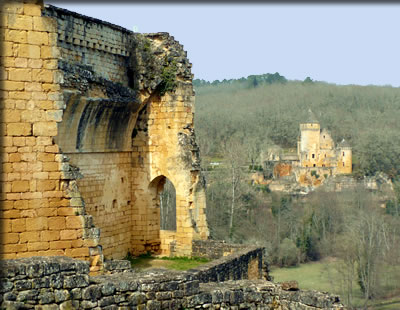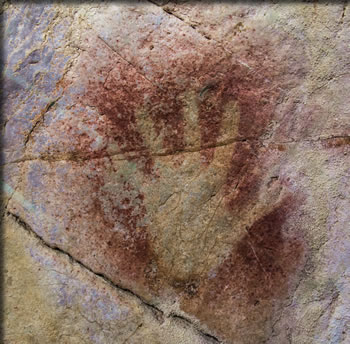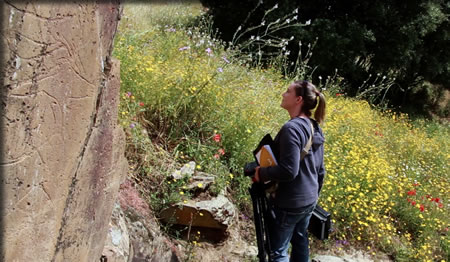European Ice Age Art

Discover Five Regions You Can Visit Today!
“Two hundred thousand years ago, modern humans appeared on the African landscape for the first time. They had our bodies; they had our brains. But the real question is: When did they become us? When did they start to behave in a truly modern way, tapping into all the creative potential of the human mind?” Excerpt from The First Signs: Unlocking the Mysteries of the World’s Oldest Symbols by Genevieve von Petzinger.
I have the privilege of working at some of the most restricted archaeological locations in the world: the rock art sites of Ice Age Europe. Found in caves, rock shelters, and the occasional open-air site, these painted and engraved images date to between 10,000 and 40,000 years ago (though a recent study has dated three cave paintings to 65,000 years). To put this in perspective, the oldest Ice Age art is almost twenty times older than the Roman Empire. In a lot of ways it is astonishing that any of it has even survived into the present.
Over the past few years, I’ve worked at over fifty of these sites, and visited even more, and I can tell you firsthand, that it really is an extraordinary experience to stand in front of any one of these images. Even more than tools or other types of Ice Age artifacts, there’s something about the art that seems to resonate, to bridge that immense time gap, to connect us with the artist through our shared humanity.

A securely-padlocked green door is a typical Ice Age cave entrance right across western Europe. ©Dillon von Petzinger
At this time there are less than 400 known rock art sites in Europe, covering 30,000 years of prehistory, which is why these rare glimpses into the minds and imaginations of these distant ancestors are so heavily protected. With that said, there are a small number of sites in Western Europe that currently allow limited public access as the governments in these countries do recognize the value in sharing these special places with those who are fascinated by this ancient chapter in our collective history.

The black stag in Las Chimeneas cave, northern Spain, was made about 17,000 years ago. This UNESCO World Heritage Site cave is open to the public just one day a year. Book your ticket early! ©Dillon von Petzinger
Below are five regions in particular where the interested traveler may immerse in the Ice Age experience – just don’t forget to bring appropriate clothing (the average cave temperature is between 12 and 15 degrees Celsius) and to wear shoes with good grip as cave floors can be uneven and/or slippery.
The Dordogne, France
In the region around the picturesque village of Les Eyzies-de-Tayac and the excellent National Museum of Prehistory, there are more than a dozen cave and rock shelter sites open to the public including ones showcasing paintings, engravings and even unusual bas-relief sculptures. These include government sites as well as private ones. Sites like Font-de-Gaume (one of the best painted sites still open to the public) and Les Combarelles (known for its hundreds of engravings) are government-run and tickets are limited – a small number can be reserved ahead of time, but otherwise plan to line up at the ticket office early in the morning to get tickets for that day.

It is no exaggeration to say that decorated caves are abundantly scattered throughout France’s Dordogne region, as under both these fortifications (above) and along the picturesque valleys that create this area’s memorable scenery (below). ©Dillon von Petzinger

Entry to private sites is also limited – in most cases tours happen at set times and can be reserved online or by phone (e.g. Grotte du Sorcier, or Rouffignac with its easy-access train tour), or in the case of Bernifal, by driving by the cave and calling the phone number on the sign (00 33 6 74 96 30 43) to book directly with the owner (note: he does not speak English and tours are French-only, but it is a site well worth visiting). Within easy driving distance are other famous sites like Pech-Merle and Cougnac – this region is certainly a rich one in terms of its Paleolithic history.
Midi-Pyrénées, France
Having never worked at any rock art sites in the Midi-Pyrénées region, I can’t speak about any of them from personal experience, though here too there are some spectacular decorated caves that remain open to the public. These include sites like Niaux with its famous paintings that continue far underground, and Bédeilhac with its paintings, engravings and unusual use of clay, making the Midi-Pyrénées another region well worth considering.

Niaux Cave has two kilometers of painted galleries open to the public. CRT Midi Pyrénées – Dominique VIET
Isturitz-Oxocelhaya, France
Located in the Pyrénées-Atlantiques region in the southwestern corner of France, there is a hillside that contains two interesting privately-owned caves that are both open to the public. Stacked one on top the other, the sites of Isturitz and Oxocelhaya between them cover tens of thousands of years of prehistory – from Neanderthals all the way through to the end of the Ice Age and beyond.
Another thing that makes these caves special is their location at the crossroads of France and Spain. Isturitz in particular, with its cathedral-like main chamber, seems to have been a hub for trade and inter-tribal gatherings during the Ice Age. And, along with engravings and paintings, these sites have also yielded a wealth of portable artifacts including carved jewelry pieces, a number of bone flutes (some of the oldest in the world), and elaborately decorated bone and antler items – many of which (both originals and reproductions) are at the museum on site.

Isturitz and Oxocelhaya are a treasure trove of Ice Age art and artifacts. C. Levillain, Association GAZTELU
Cantabria, Spain
Like the Dordogne in France, the Cantabrian region of northern Spain was a hotbed of Ice Age activity, and there are over forty cave art sites in this area alone. Of these, seven are open to the public, including El Castillo which contains some of the oldest known art in the world (dating to almost 41,000 years ago), along with a rich assortment of other paintings and engravings spanning the entire late glacial period in Europe.
In the same hillside is the cave of Las Monedas, with its beautiful calcite formations and some art of its own, making a visit here an absolute must for any Paleo enthusiast. Each of the other open caves highlights different features of the Cantabrian art tradition along with other elements of prehistory, and all tours can be booked on a single government website (note that some caves are easy access, while others require a bit of crawling, so be sure to read the tour description before booking).
 The large El Castillo cave system in northern Spain offers highly recommended guided tours numerous times a day. Among the oldest art are a large number of hand prints some dating from 37,000 years ago. Some hand prints have been identified as being those of women and children. There are also fine drawings of horses, deer, mammoth and bison. ©Dillon von Petzinger
The large El Castillo cave system in northern Spain offers highly recommended guided tours numerous times a day. Among the oldest art are a large number of hand prints some dating from 37,000 years ago. Some hand prints have been identified as being those of women and children. There are also fine drawings of horses, deer, mammoth and bison. ©Dillon von Petzinger
In addition to the Cantabrian art caves, there are two top-notch museums in the region – a recently opened museum of prehistory in the state capital, Santander, and the Altamira museum, which includes a vast replica cave featuring many of the most famous paintings from the original Altamira cave that is now closed to the public.
Coa Valley, Portugal
Visiting the Côa Valley is like stepping back in time. Unlike other parts of Europe where the environment has drastically changed since the Ice Age, here, the climate and the landscape remain virtually the same. On top of that, the engraved images in this northeastern region of Portugal are all found in the open-air – an even rarer type of site than the caves because of the millennia of weathering they have had to endure in order to survive. Between the world-class Côa Museum and the excellent guide-driven 4×4 vehicle tours of the sites, a trip to this region is not to be missed. (Editor’s note: see the complete Côa Valley story in our Travel Article Library.)

Portugal’s Coa Valley open air site has so far revealed over 5,000 engraved animal images across a landscape unchanged through the millennia. ©Dillon von Petzinger
If Ice Age art is something that does intrigue you, I would encourage you to visit these sites – particularly the caves – sooner rather than later. If at any time damage to these delicate micro-environments is detected, government officials will choose preservation over public interest, and access to these caves could end up being even more restricted, if not being closed entirely.
And, while it is not likely that the door will shut completely on all cave art sites in the near future, the way we access sites and interact with these fascinating images is already starting to change. Wonderfully accurate, large replicas such as Lascaux (see photo caption, below) and Chauvet in France, along with Altamira in Spain, are opening up this experience and making the art more accessible for all.
I highly recommend such replicas since you can spend more time studying the art in less cramped conditions, while still getting a sense of what the caves were like. However, if you like the idea of following in the literal footsteps of these ancient artists, then now would be the time to make your journey before more green doors are locked on the original cave sites.

Dating to 18,000 years ago, the original world famous Lascaux Cave closed to the public in 1963, and a partial replica site opened to visitors in 1983. In late 2016, a brand new comprehensive replica site, Lascaux IV, opened in the Dordogne. jj Brochard/CRTA

 “If you love mysteries, you’ll love this book. Archaeologist Genevieve von Petzinger acts as guide and sleuth in this fascinating, accessible, and fast-paced exploration of Ice Age artists and the evocative cave paintings they left behind. You’ll feel as if you’re with her as she plunges into caverns to examine the ancient and exquisite depictions of horses, mammoths, and bison. And you’ll puzzle with her over the strange, abstract symbols the artists often painted alongside the animals. Scientists have long debated these images. Now, von Petzinger offers a new way to think about why our distant relatives created this art, and what it means. You’ll come away with a deeper appreciation for these great artists, their love of animals and the natural world, and their connection to us.” (Virginia Morell, journalist and author of Animal Wise and Ancestral Passions)
“If you love mysteries, you’ll love this book. Archaeologist Genevieve von Petzinger acts as guide and sleuth in this fascinating, accessible, and fast-paced exploration of Ice Age artists and the evocative cave paintings they left behind. You’ll feel as if you’re with her as she plunges into caverns to examine the ancient and exquisite depictions of horses, mammoths, and bison. And you’ll puzzle with her over the strange, abstract symbols the artists often painted alongside the animals. Scientists have long debated these images. Now, von Petzinger offers a new way to think about why our distant relatives created this art, and what it means. You’ll come away with a deeper appreciation for these great artists, their love of animals and the natural world, and their connection to us.” (Virginia Morell, journalist and author of Animal Wise and Ancestral Passions)
“The author’s style adds immensely to the enjoyment of the book. Von Petzinger’s findings are significant for comprehending the origins of symbolic thinking… An exceptional read that should capture the imagination of anyone fascinated by time, humanity, and prehistory.” (Library Journal, Starred Review)
Publisher: Atria Books (May 2016), an imprint of Simon and Schuster. Paperback, 320 pages, US$18.99, 8-page color insert, b&w photos and illustrations throughout. ISBN-13: 978-1476785493. Available in local book stores or from online booksellers.
See also the author’s 12-minute TED Talk, “Why are these 32 symbols found in ancient caves all over Europe?” which has attracted a truly remarkable 9.4 million views thus far since its Internet launch, and her 8-minute National Geographic Emerging Explorer talk, “Ice Age Cave Art”. To excite the grandchildren check out this 4-minute YouTube video: National Geographic Kids, “The Truth Behind” series where the author takes school-age children on an expedition to California’s scorching desert to discover 10,000 year old rock art.
